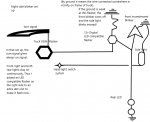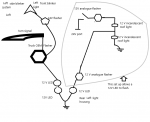So my rear blinker bulbs were good, but they started needing some warm up before blinking, especially the right side, and then the right one stopped altogether, and then the left started getting longer warm up period too and a few weeks later went out too, getting this apparent common creeping gremlin on the M923. Meanwhile I also broke my turn signal handle, the plastic got old. I ordered the cheaper turn signal they had out there.
I thus decided to go to NAPA and buy cheap trailer LEDs, hooked them and every thing was fine for a few weeks for the back blinkers. And then one of the LEDs burned out on the right, so I decided to put more LEDs in series to make it 24 V and it worked for a while and then the right side stopped working but the left is good... well, sort of, the right side is a stay ON for the two blinkers in the back and the one in the front right, instead of flashing for both front and back to the right with the left rear off. When going on hazards I get all 4 on permanent, no blinking.
So, I went to Auto Zone and got a $12 LED compatible flasher and hooked its plus side to the power of the front blinker and run from the L port to both the front right light and the rear right in series. Since it is electronic it does require to have the third negative terminal grounded. And it works when I put my alligator plugs to test it.
However something really strange happened when I started making the fixture more permanent. It is that when the grounding is weak, the small orange side light on the front blinker started flashing with the rear blinker lights but not the front blinker lights. And if I made a very good ground, then the front and back blinker worked but the side orange light stopped.
I thought that was really weird that a bad ground makes the side orange safety light blink on and not the front blinker, but when the ground is good, it shuts off and passes on the energy to the front facing blinker light. The rear LEDs worked fine.
In any case, I think my original problem must have been a bad ground on one of the lights fixtures or somewhere else. Even though the Ohm meter beeps good, it probably is not good enough.
So far I decided to leave it as it is as it is working like that.
I thus decided to go to NAPA and buy cheap trailer LEDs, hooked them and every thing was fine for a few weeks for the back blinkers. And then one of the LEDs burned out on the right, so I decided to put more LEDs in series to make it 24 V and it worked for a while and then the right side stopped working but the left is good... well, sort of, the right side is a stay ON for the two blinkers in the back and the one in the front right, instead of flashing for both front and back to the right with the left rear off. When going on hazards I get all 4 on permanent, no blinking.
So, I went to Auto Zone and got a $12 LED compatible flasher and hooked its plus side to the power of the front blinker and run from the L port to both the front right light and the rear right in series. Since it is electronic it does require to have the third negative terminal grounded. And it works when I put my alligator plugs to test it.
However something really strange happened when I started making the fixture more permanent. It is that when the grounding is weak, the small orange side light on the front blinker started flashing with the rear blinker lights but not the front blinker lights. And if I made a very good ground, then the front and back blinker worked but the side orange light stopped.
I thought that was really weird that a bad ground makes the side orange safety light blink on and not the front blinker, but when the ground is good, it shuts off and passes on the energy to the front facing blinker light. The rear LEDs worked fine.
In any case, I think my original problem must have been a bad ground on one of the lights fixtures or somewhere else. Even though the Ohm meter beeps good, it probably is not good enough.
So far I decided to leave it as it is as it is working like that.




